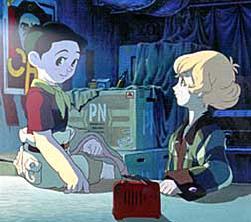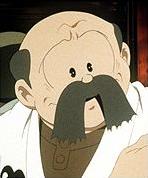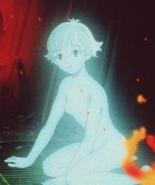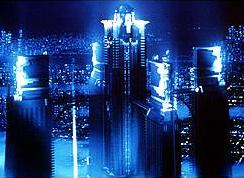But first, before we begin, a little history lesson.
"Metropolis" is the brainchild of Osamu Tezuka, the man who pretty much created the manga and anime genres. Running from 1947 to 49, "Metropolis" was a manga that told the story of humans and robots living together in a future society - Tezuka was inspired to write it after seeing a single still photograph of the robot woman from Fritz Lang's silent 1926 movie, also named "Metropolis." Tezuka had later success with "Mighty Atom" (known as "Astro Boy" in the West), which overshadowed his earlier works. Acclaimed anime director Rintaro, who had worked with Tezuka on the "Mighty Atom" animated series, suggested an animated version of "Metropolis," but Tezuka refused, holding no regard for his early work. Following Tezuka's death in 1989, Rintaro revisited the idea, and together with scriptwriter Katsuhiro Otomo (who also wrote, among others, the classic "Akira") brought "Metropolis" to the big screen.
So, now that you know that, let's get down to business.
In the futuristic multi-layered city of Metropolis, construction of the awesome Ziggurat has been completed by the powerful socialite, Duke Red (Ishida/Price). Believed to be a monument by the public, the Ziggurat is in fact a weapon that will give Duke Red ultimate power - but the final key needed to unlock that power is Tima (Imoto/Forstadt), a superhuman android built in the likeness of Red's deceased daughter. However, Duke Red's jealous, robot-hating adopted son, Rock (Okada/Reisz - that's him on the cover up there) - a member of Red's anti-robot security force, the Malduks - destroys the laboratory in which she is being constructed, but the blast fails to destroy her and she winds up lost in the layers beneath Metropolis with Kenichi (Kobayashi/Siddall), nephew of Detective Shunsaku Ban (Tomita/Pope), who has come to Metropolis to arrest the very doctor responsible for Tima's creation. An unlikely romance is formed between the boy and the android, who knows nothing of what she is, and as a rebel uprising rages around them, the race is on to keep Tima from the clutches of all those who would see her destroyed or used.
The first thing that will really grab you about "Metropolis" is its animation. The characters are rendered in a style that is adapted from Tezuka's own style of drawing, and are not what has come to be considered by the West as the traditional way anime looks. They resemble nothing so much as characters from Herge's "Adventures of Tin-Tin," or even "Popeye." The packaging for the disc is deceptive, showing only images of Rock and Tima, and could make you believe that the animation is more "traditional" that you'll be expecting. I admit to being jarred by the very cartoonish appearances, but once I
 was used to it, it became very
enjoyable. The big thing about the animation for the movie,
however, is that all of the backgrounds are rendered in CGI. That
in itself is quite a feat, but what's most impressive is that the
CGI backgrounds and normal cell animated characters are blended
together flawlessly. If nothing else, "Metropolis" is a
visual feast - the future it depicts is that envisioned in the
early part of this century, and the art style and desgins are
very much rooted in that era..
was used to it, it became very
enjoyable. The big thing about the animation for the movie,
however, is that all of the backgrounds are rendered in CGI. That
in itself is quite a feat, but what's most impressive is that the
CGI backgrounds and normal cell animated characters are blended
together flawlessly. If nothing else, "Metropolis" is a
visual feast - the future it depicts is that envisioned in the
early part of this century, and the art style and desgins are
very much rooted in that era..The plot could use a little sprucing up, however. It's not insanely complex, like several anime movies I can think of, and is just straightforward enough to allow it to appeal to a wider age group (though make no mistake - just because it's rated PG and has cartoonish animation doesn't mean young kids are going to lap it up, because they'll be lost in no time at all). There are some areas that are simply not developed enough, however, such as how Duke Red got to his position in the first place, and certainly the story of the revolutionaries and their uprising is not given enough screen time. Most notably, Kenichi and Tima's romance comes across as a little forced - my brother, for example, prefers to think of it as a friendship rather than a romance, and while I know that it's intended as the latter, the former does fit better within the confines of what we see happen between the two on-screen.
Many characters are a bit one-dimensional - but perhaps this is not so unintentional, as the human characters in Lang's original "Metropolis" were allegories, rather than characters in their own right. Whatever the case, Shunsaku and Kenichi are probably the biggest offenders here - Kenichi is... well, to be honest, pretty boring and unremarkable as a character. Shunsaku, though, is amusing, and gets some nice interaction with other characters. Duke Red has unexplored depths - he's obviously not just a power-mad tyrant, but is more one of those individuals who sees humans as weak and inferior to what can be artificially created. And he creates his ultimate weapon in the form of his dead daughter, so you know he's got some issues. And speaking of issues, Red's son, Rock, is
 probably the most interesting character
in the film - which is ironic, as he did not exist in Tezuka's
original manga, and was instead taken from another of Tezuka's
works, "Boy Detective Rock Home," and transplanted into
the "Metropolis" screenplay with a new, villainous
personality. Rock is the antithesis of his adoptive father,
hating robots and being repulsed at the notion of putting one in
a position of power. But despite these disagreements, and the
fact that Duke Red treats him like crap, not considering him his
son, Rock loves the man who raised him, and manages to be a
sympathetic character as a result.
probably the most interesting character
in the film - which is ironic, as he did not exist in Tezuka's
original manga, and was instead taken from another of Tezuka's
works, "Boy Detective Rock Home," and transplanted into
the "Metropolis" screenplay with a new, villainous
personality. Rock is the antithesis of his adoptive father,
hating robots and being repulsed at the notion of putting one in
a position of power. But despite these disagreements, and the
fact that Duke Red treats him like crap, not considering him his
son, Rock loves the man who raised him, and manages to be a
sympathetic character as a result.The robots of the movie are nothing if not endearing. Tima brings to mind a child-like Motoko Kusanagi (from "Ghost in the Shell"), struggling with questions similar to those faced by that character - not knowing if she is human or robot - but looking at them with a child's perspective, which helps to make her plight more accessible to the casual viewer (who most likely fell asleep during Kusanagi's endless streams of needlessly complicated technical jargon in GitS). The irony once again is that Tima was not in the original manga - in her place was the androgynous Michi, replaced with the female Tima to obviously shape a romance with Kenichi. Tima, though, is unique in her human appearance - the other robots of the movie are somewhat more simplistic. There's no giant, hugely detailed, 'see-every-gear-moving-inside-them' mecha here - instead we have a collection of cute robots such as Fifi (Rikako Aikawa/Siddall again), who aids the children, and looks as if s/he was cobbled together from a trash can and some plungers, or the simple, humanoid detective robot, Pero (Wakamoto/Mallow) - designs that are a product of the time in which they were created by Tezuka.
"Metropolis" pays homage in serious doses to "Blade Runner," in ways such as the concept of a multi-layered society, which was not in the original manga. The cream of the crop live on surface level in Metropolis, while everyone else lives below ground in Zone One (which isn't as bad as you might think). The Malduks are very similar to the notion of the Blade Runners, but I'm not aware if they were in the original manga or not.
I've already said that the story isn't one to bend your brain, but when you look a little deeper, there are also interesting religious metaphors and imagery at work. A Ziggurat, you see, was a tower built in ancient Mesopotamia as a symbol of power. The Tower of Babel was the most famous one, and it was destroyed by God - when the Ziggurat in "Metropolis" crumbles, it has been
 destroyed by the "messiah" of
robots (for lack of a better term), who in herself was man made.
Observe when the panelling falls away around her, as the first
shape left by the empty space is a cross, in which she is at the
centre. A scene earlier in the film has a bird land on Tima's
shoulder, and we then see her from an angle which merges the two,
making it appear as if she has an angel's wings.
destroyed by the "messiah" of
robots (for lack of a better term), who in herself was man made.
Observe when the panelling falls away around her, as the first
shape left by the empty space is a cross, in which she is at the
centre. A scene earlier in the film has a bird land on Tima's
shoulder, and we then see her from an angle which merges the two,
making it appear as if she has an angel's wings.The soundtrack of the movie is toe tapping, to be sure, mostly consisting of jazz music - which is a fairly surprising choice, but, like the art style of the film, the soundtrack is specifically chosen as a product of the era in which "Metropolis" was originally created. The title theme of the movie is particularly infectious, and you will likely find yourself humming it. Perhaps most unusual is the use of Ray Charles's "I Can't Stop Loving You," during the final scenes of the film, in an imitation of the conclusion of Stanley Kubrick's "Doctor Strangelove," as it plays over mass destruction. While musically it is out of place - which is intentional - lyrically, it's meaning is two-fold. Despite the fact that he now knows Tima is a dangerous robot who's almost just destroyed everything, Kenichi "can't stop loving" her, trying to save her in vain. But also, it applies to Rock and Duke Red - despite the fact that his father doesn't respect him or treat him well, Rock "can't stop loving" him either.
The English voice cast is well chosen - it makes me very happy to see that they actually decided to utilise real experienced voice actors, even though the movie was theatrically released - compare with the celebrity actors used in "Princess Mononoke." Digimon fans will already have noted from this review that almost the whole main cast is composed of actors who have worked on the show - the voices of Calumon, Matt, Oikawa, Zhuqiaomon and Angemon (Siddall, Reisz, Price, Pope and Mallow, respectively), to be precise. Also keep your ears peeled for Steve Blum (Guilmon) as Lamp, Robert Axelrod (Armadillomon) as Ham and Egg, Dan Woren (Mimi's dad) as Skunk, Doug Erholtz (02 T.K.) as one of the revolutionaries, Barbara Goodson (Rika's Grandmother) as Enmy, Peter Spellos (Meramon) as the mayor, and Tom Wyner (Devimon) in various cameo roles. Listen *very* carefully, and you'll also hear Digimon's own Mary Elizabeth McGlynn doing female voices over loudspeakers - in fact, it was she (together with Marc Handler) who wrote the English Language Version of the movie. It's a small world!

But, this is a DVD, so the movie is not all there is to see. A two-disc set, the first disc features the movie in widescreen, with English and original Japanese language tracks. Subtitles available are the English translation of the original Japanese, and also the English language version itself - but I'll be buggered if I can figure out which is supposed to be which, because neither of them actually match the words being spoken on screen to any greater degree than the other. Other subtitles are avaialble, but the Region One and Region Two discs differ on what they are. This disc also contains scene selection and trailers for the movie itself, "Final Fantasy: The Spirits Within," and "Roughnecks: Starship Troopers Chronicles - The Tesca Campaign."
The second disc, meanwhile, contains the bulk of the extra booty. Included here are interviews with Rintaro and Otomo, two multi-angle animation comparisons which show how scenes were made, a photo gallery of character model sheets and design sketches, a history of the Metropolis comic and how the movie project came to be, filmographies for Rintaro and Tezuka, and a full-length Japanese TV special, "The Making of Metropolis." You're certainly getting what you pay for - most of the factual information about the history of "Metropolis" that I've related here, I learned from the discs, although there is no mention of Lang's "Metropolis," for whatever reason.
OVERALL